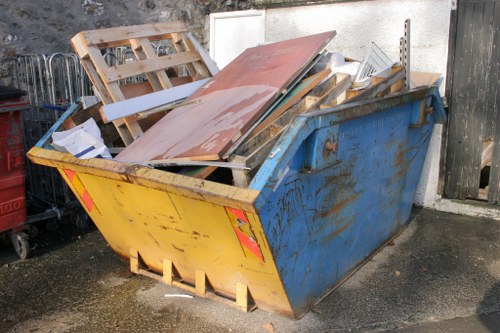Efficient Strategies for Large Item Collection in Furniture Disposal
Understanding Furniture Disposal

Furniture disposal is a critical aspect of maintaining a clean and organized living or working space. Whether you're renovating, downsizing, or simply decluttering, knowing how to efficiently dispose of large items can save you time, money, and environmental resources.
Large items, such as sofas, tables, and wardrobes, often pose significant challenges when it comes to disposal. Their size and weight make them difficult to transport and manage, necessitating specialized collection services or disposal methods.
Moreover, improper disposal of large furniture pieces can lead to environmental harm. Many furniture items contain materials that are not biodegradable and can contribute to landfill overflow if not handled correctly.
Importance of Professional Furniture Disposal Services

Professional furniture disposal services offer several advantages over attempting to dispose of large items independently. These services are equipped with the necessary tools and expertise to handle bulky furniture efficiently and safely.
By hiring professionals, you ensure that your furniture is disposed of in an environmentally responsible manner. Many disposal companies adhere to recycling and donation protocols, minimizing the environmental impact of your discarded items.
Additionally, professional services save you valuable time and effort. Instead of arranging transportation or scheduling multiple pickups, experts handle the entire process, allowing you to focus on other important tasks.
Environmental Benefits of Proper Furniture Disposal

Proper furniture disposal plays a significant role in environmental conservation. Many large furniture items contain materials like wood, metal, and fabric that can be recycled or repurposed, reducing the need for raw material extraction.
Recycling furniture not only conserves natural resources but also reduces energy consumption associated with manufacturing new products. This process lowers greenhouse gas emissions, contributing to the fight against climate change.
Furthermore, donating usable furniture extends the lifespan of these items, providing them with a second life and reducing overall waste. This practice supports communities and organizations that can benefit from free or low-cost furniture donations.
Cost-Effective Disposal Solutions

While some may perceive professional furniture disposal as an added expense, it can actually be a cost-effective solution in the long run. By preventing potential fines for improper disposal and avoiding the costs associated with transporting large items yourself, hiring experts can save you money.
Many disposal companies offer competitive pricing packages tailored to different needs, ensuring that you only pay for the services you require. Additionally, some services include pickup, transportation, and recycling, eliminating the need for multiple service providers.
Moreover, donating furniture can provide tax benefits, further enhancing the cost-effectiveness of proper disposal. By contributing to charitable organizations, you not only help those in need but also receive financial incentives in return.
Steps to Effective Large Item Collection

To ensure a smooth and efficient large item collection process, follow these essential steps:
- Assessment: Begin by evaluating the condition and size of the furniture items you wish to dispose of. Determine whether they are recyclable, reusable, or need to be discarded.
- Research: Identify reputable furniture disposal services in your area. Look for companies with positive reviews, proper licensing, and environmentally friendly practices.
- Scheduling: Contact your chosen disposal service to schedule a convenient pickup time. Provide detailed information about the items to ensure appropriate resources are allocated.
- Preparation: Prepare the furniture for collection by cleaning and disassembling larger pieces if necessary. This step facilitates easier transportation and handling.
- Pickup: On the scheduled date, the disposal team will arrive to collect the items. Ensure clear access to the furniture to expedite the process.
- Post-Collection: Confirm that all items have been collected and inquire about any follow-up services, such as recycling certification or donation receipts.
Following these steps ensures that your large item collection is handled efficiently and responsibly, minimizing stress and environmental impact.
Choosing the Right Disposal Service
Selecting the appropriate disposal service is crucial for effective large item collection. Consider the following factors when making your choice:
- Reputation: Research customer reviews and testimonials to gauge the reliability and quality of the service.
- Services Offered: Ensure the company provides comprehensive services, including pickup, transportation, recycling, and donation options.
- Pricing: Compare pricing structures to find a service that fits your budget without compromising on quality.
- Environmental Practices: Choose companies committed to sustainable practices, such as recycling or donating items whenever possible.
- Licensing and Insurance: Verify that the disposal service is properly licensed and insured to protect against potential damages or liabilities.
By carefully evaluating these factors, you can select a disposal service that meets your needs and aligns with your values.
Preparing Your Furniture for Disposal
Proper preparation of your furniture items ahead of collection can streamline the disposal process. Here are some key tips:
- Clean the Items: Remove any dirt, dust, or stains to ensure the furniture is in good condition for potential recycling or donation.
- Disassemble If Possible: Taking apart larger pieces can make transportation easier and may be required by some disposal services.
- Remove Personal Items: Ensure that all personal belongings are removed from the furniture before collection.
- Secure Loose Parts: Fasten any loose screws or parts to prevent loss or damage during transit.
- Measure Doorways and Hallways: Confirm that the furniture can be easily moved from its current location to the exterior for pickup.
These preparatory steps not only facilitate a smoother pickup but also increase the likelihood of your furniture being repurposed or recycled effectively.
Maximizing Space with Efficient Disposal
Effectively disposing of large items helps maximize available space in your home or office. Clutter-free environments contribute to better productivity, reduced stress, and a more aesthetically pleasing setting.
By removing bulky furniture, you create room for new pieces or simply enjoy the benefits of a more open and organized space. This can enhance the overall functionality and comfort of your environment.
Additionally, efficient disposal prevents the accumulation of unnecessary items, promoting a minimalist lifestyle and fostering a sense of well-being.
Innovative Furniture Disposal Methods
Modern disposal methods have evolved to address the challenges of large item collection. Innovations in recycling technology and sustainable practices have made it easier to manage bulky furniture responsibly.
Some disposal services now offer on-site recycling, where materials are separated and processed immediately after collection. This approach reduces transportation costs and ensures that recyclable materials are efficiently utilized.
Furthermore, the rise of circular economy principles encourages the reuse and refurbishment of furniture items. Companies are increasingly partnering with refurbishers and second-hand retailers to extend the life cycle of large furniture pieces.
Legal Regulations and Compliance
Understanding local regulations regarding furniture disposal is essential to ensure compliance and avoid potential fines. Different regions have varying rules about what can be disposed of, recycled, or donated.
Many municipalities require specific disposal methods for large items, including mandatory recycling or donation for certain materials. Being aware of these regulations helps you choose the right disposal strategy and service provider.
Non-compliance can lead to legal repercussions and environmental penalties, emphasizing the importance of informed and responsible disposal practices.
Benefits of Recycling Large Furniture Items
Recycling large furniture items offers numerous environmental and economic benefits. By diverting furniture from landfills, recycling conserves valuable resources and reduces the overall ecological footprint.
Recycled materials from furniture, such as wood and metal, can be repurposed into new products, reducing the need for raw material extraction and processing. This contributes to sustainable manufacturing practices and lowers energy consumption.
Economically, recycling creates job opportunities in the recycling and manufacturing sectors, supporting local economies and fostering community development.
Donation Opportunities
Donating large furniture items is an excellent way to extend their usefulness and support charitable causes. Many organizations accept gently used furniture, providing it to those in need or for community projects.
Donation not only benefits recipients but also offers tax incentives for donors, making it a mutually beneficial arrangement. Furthermore, it helps reduce waste by giving furniture a second life instead of contributing to landfill mass.
When considering donation, ensure that the furniture is in good condition and meets the specific requirements of the receiving organization. This increases the likelihood of successful donation and maximizes the positive impact.
Tenant Responsibilities in Furniture Disposal
For tenants, proper furniture disposal is often governed by lease agreements and local regulations. Understanding your responsibilities helps avoid potential conflicts with landlords and ensures compliance with legal standards.
Many leases stipulate that tenants must dispose of furniture in designated areas or through approved methods. Failure to adhere to these guidelines can result in fines or deductions from security deposits.
Collaborating with landlords to arrange for professional disposal services can streamline the process and ensure that all parties adhere to the agreed-upon terms.
Challenges in Large Item Collection
Collecting and disposing of large furniture items comes with its set of challenges. Limited access, such as narrow staircases or crowded neighborhoods, can complicate the pickup process.
Additionally, the sheer weight and size of bulky furniture require specialized equipment and handling to prevent damage to the items and property. Without proper tools, there's a risk of injury or accidental property damage.
Time constraints and scheduling conflicts can also pose challenges, making timely disposal difficult. Planning and coordination with disposal services are essential to mitigate these issues.
Safety Precautions During Furniture Disposal
Ensuring safety during the disposal of large furniture items is paramount. Both the individuals involved and the property should be protected from potential hazards.
- Wear Protective Gear: Utilize gloves, sturdy footwear, and other protective equipment to prevent injuries while handling heavy items.
- Clear Pathways: Remove obstacles and ensure that pathways are free from clutter to facilitate easy movement of furniture.
- Use Proper Lifting Techniques: Employ techniques such as bending at the knees and keeping the back straight to avoid strains and injuries.
- Utilize Equipment: Use dollies, straps, and other equipment to assist in moving heavy items safely.
- Secure the Area: Ensure that the disposal area is secure to prevent accidents or unauthorized access during the process.
Adhering to these safety precautions minimizes the risk of accidents and ensures a smooth and secure disposal process.
Impact of Sustainable Disposal Practices
Adopting sustainable disposal practices for large furniture items significantly contributes to environmental preservation. Sustainable methods encourage the reduction, reuse, and recycling of materials, fostering a circular economy.
By prioritizing sustainability, individuals and organizations help decrease the demand for new raw materials, reducing habitat destruction and resource depletion.
Moreover, sustainable disposal practices promote social responsibility and environmental stewardship, inspiring others to follow suit and collectively enhance global sustainability efforts.
Conclusion: Making Informed Disposal Decisions
Effective large item collection in furniture disposal requires a combination of strategic planning, professional services, and sustainable practices. By understanding the importance of proper disposal, leveraging professional expertise, and adhering to environmental standards, you can manage bulky furniture items efficiently and responsibly.
Embracing these methods not only benefits your immediate environment but also contributes to broader ecological and social well-being. Make informed disposal decisions today to pave the way for a cleaner, greener, and more organized tomorrow.
Contact us today to learn more about our professional furniture disposal services and take the first step towards a clutter-free and environmentally responsible space.